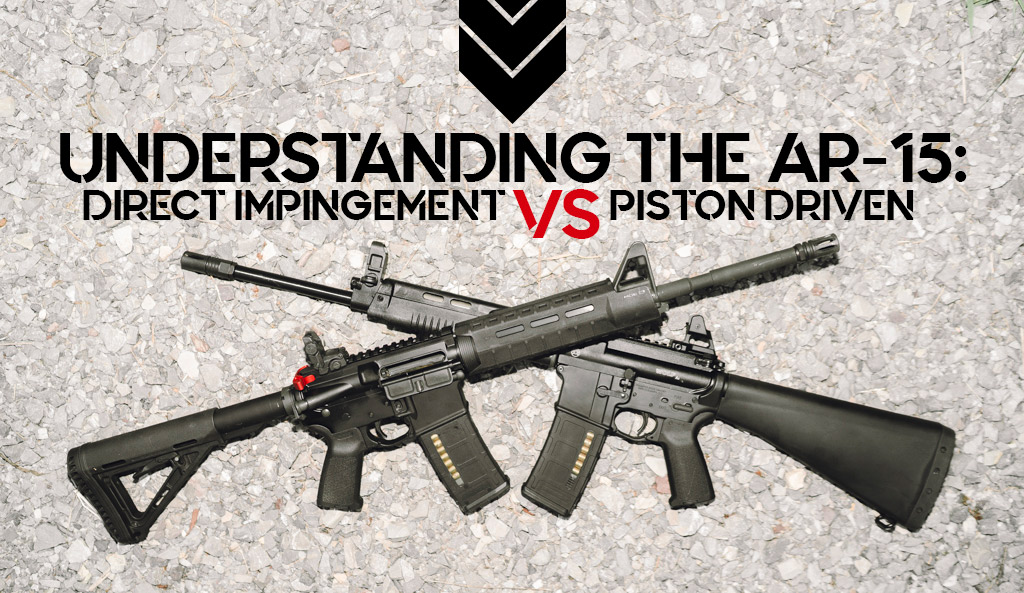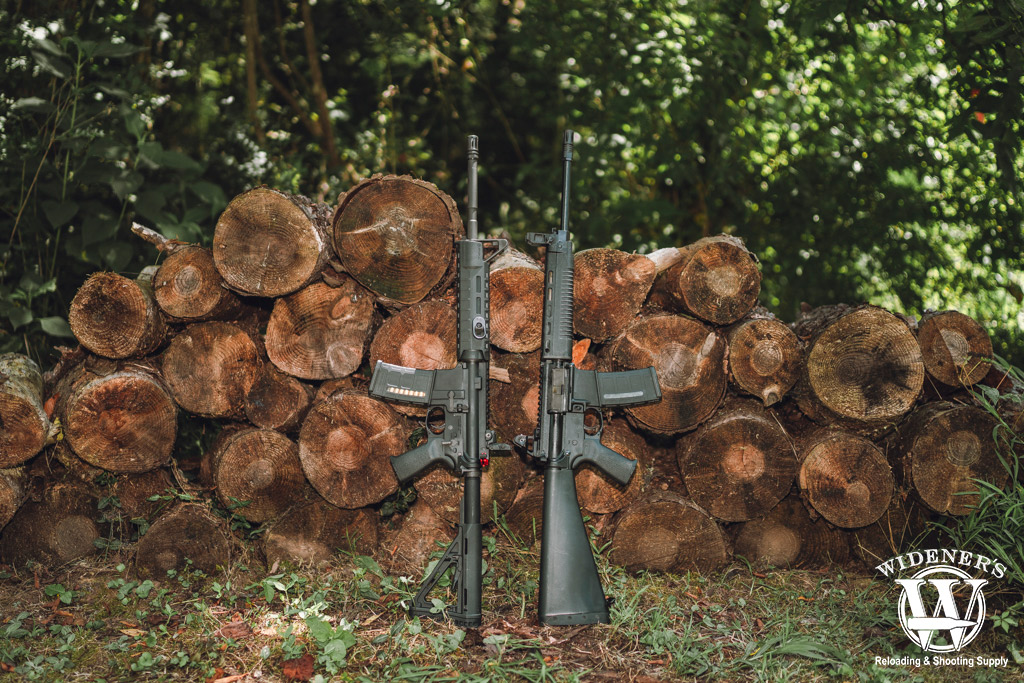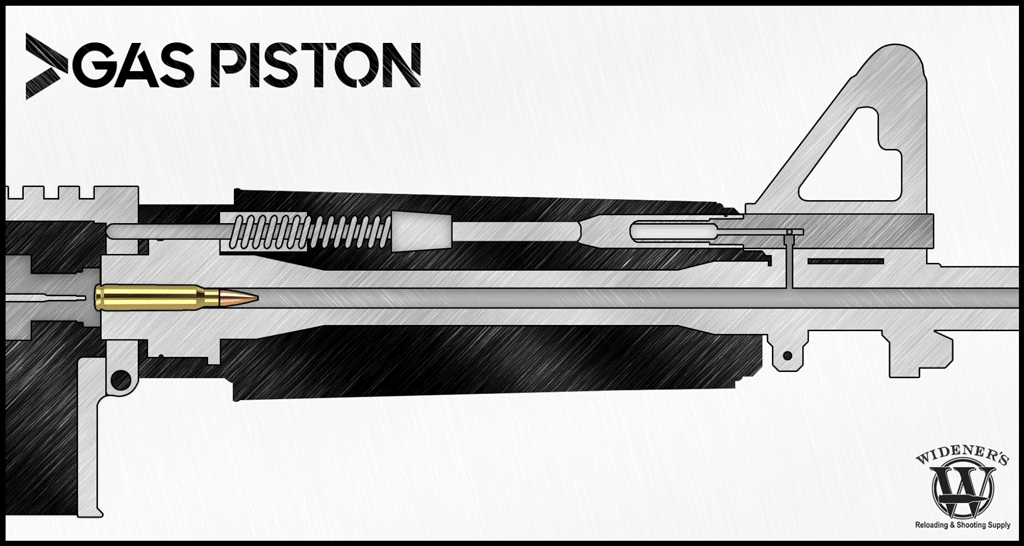

By Guy J. Sagi
The variety of modern sporting rifles available today is staggering, ranging from basic and utilitarian to fully tricked-out race guns. Regardless of style, price or accessories, all harness a portion of the hot gas released with each shot to fuel their semi-automatic operation. There are two methods of putting that captured energy to work, however, understanding the difference between direct impingement VS piston driven ARs can help you make the right purchase decision.
It’s important to note that both systems are extremely reliable and have enviable, decades-long records of performing well in harsh conditions. Their “engines” are not quite the same, however, and the subtle differences are noteworthy, even from a historic perspective.
Basics Of Operation

Direct impingement VS piston driven rifles have similarities, both share a gas block designed to capture gas as the rifle cycles.
All AR barrels, regardless of design, have a gas block. Its primary function is to siphon some of the high-pressure gas as it drives a bullet down the bore.
It does so through a gas port, which provides a convenient escape for some of the high-pressure gas temporarily trapped between a traveling projectile and bolt face. The percentage of energy diverted into that path of least resistance is determined by that hole’s size.
Here is where the systems of AR operation diverge. One remains relatively true to Eugene Stoner’s original 1956 patent, while the other incorporates an approach that earned respect for the AK-47 early during the Vietnam War.
Direct Impingement VS Piston Drive Explained
Direct Gas Impingement
In a direct gas impingement (DGI) modern sporting rifle, that diverted gas travels through a thin gas tube, directly back to where it makes contact (impinges) with the bolt carrier group. The pressure generated there is enough to push that assembly back, ejecting the empty case along the way.
Once that cycle is complete, the now-compressed buffer spring begins to push the bolt carrier group forward. During the travel it strips a fresh cartridge from the magazine and ultimately returns the gun to full lockup, ready for a follow-up shot.
Piston Driven
Gas captured in the gas block of a piston-driven system goes directly into a cylinder. An internal piston and connecting rod that runs all the way back to the bolt carrier group then moves rearward, cycling the action in the same manner as a DGI.
Mikhail Kalashnikov pioneered the piston-driven approach in his AK-47, which the Soviet Union officially adopted for its military in 1949. The performance in southeast Asia permanently cemented the system in firearm history and it works extremely well when harnessed in the AR platform.
There are subtle advantages and disadvantages to weigh in both methods of operation, though. Below are a few items to consider.
Can DGI Take The Heat?
Gas makes direct contact with the bolt carrier group in a direct gas impingement system, This, in turn, heats things up faster and can compromise lubricant performance on the critical firearm component.
It sounds like common sense, although there are several mitigating factors to weigh. Results of Congressional Committee hearings that began in 1967 are one of them. Members were searching for answers to the DGI system’s poor performance in the M16s recently fielded by U.S. troops. Heat and its impact on lubrication were contributing factors, according to the findings, but not the primary culprit.
Consider, too, that the civilian volume of fire is minuscule compared to that of wartime troops armed with an automatic rifle and unlimited ammo. Even 3-Gun competitors run DGI ARs without a problem today. Today’s high-tech lubricants are advanced by light-years when compared to what was in use before man landed on the moon. Not to mention, the weapon systems are now more reliable than ever before.
There is, however, no denying a piston-driven AR’s ability to contain that heat in a distant cylinder minimizes the amount transferred to the bolt carrier group. That advantage is of particular note if a suppressor, which always heats things up, is in your future.
Carbonized Considerations
Gas released with each shot carries powder residue—carbon being of the most concern. More of it reaches a DGI system’s bolt carrier group and breech than with a piston. That increases the accumulation and probability of stoppages. DGI ARs run dirtier.
Time for routine maintenance in the jungles of Southeast Asia was likely a rare luxury, another factor according to the committee, but it’s not the same stateside. Clean regularly and carbon buildup will rarely if ever, lead to problems at the firing line.
Parts & Physics
There are more parts to misplace, bend, break or lose in a piston system. Those added components add slightly to the weight of that operating system’s models.
Piston and rod movement also sacrifices a tiny bit of accuracy. Although the real-world effect depends on a host of factors—including shooter experience and rifle build. It’s not uncommon for experienced shooters to print almost identical groups with DGI and piston-driven ARs. Most enthusiasts will never see any difference.
Reports of increased perceived recoil with a piston-driven system—a byproduct of that added mass in motion—are not uncommon and defined by the laws of physics. The increase is not significant, if even palpable, but if follow-up shot pace is a concern, schedule range time with any model you’re considering.
Pricing The Market
DGI ARs are typically mil-spec. As a result, replacement parts are readily available and priced reasonably in most cases. Conversely, piston components can be proprietary and carry price tags to match. If a budget build is your goal, you may want to stick with the DGI option. However, keep in mind, that you can buy complete piston driven uppers. If you’d like to try both options, you can alternate between them on the same lower.
Historic Perspectives: Direct Impingement VS Piston

Piston driven rifles run much cleaner, and cooler than DGI, making them ideal for full-auto applications.
Congress failed to identify any single cause for stoppages in early M16 versions. Many experts subsequently claimed the biggest culprit was deploying rifles without chrome-lined bores to a harsh jungle environment.
Without any definitive answer, and in something of a nod to Kalashnikov’s approach, Colt developed the long piston-driven Model 703. It was ready for military consideration in 1969. Olin/Winchester shortly thereafter engineered an ingenious system to convert existing M16s to short-stroke piston models at an embarrassingly reasonable price. By then the U.S. military had sorted out the DGI problems and didn’t seriously consider either solution.
Today, the M4s standing guard in the global war on terrorism are DGI. And the piston-driven revolution that began with the AK-47 shows no sign of slowing.




